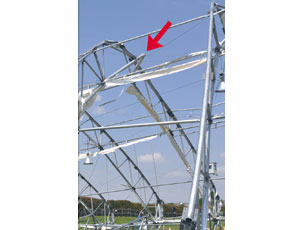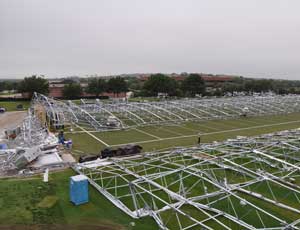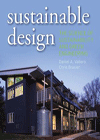The Dallas Cowboys’ Irving, Texas, practice facility collapsed on May 2, 2009, injuring 12 people, because wind-load demands exceeded the structure’s capacity to resist a thunderstorm’s 55 mph to 65 mph gusts, which were well below the 90 mph wind-speed specifications set by ASCE 7-98 and ASCE 7-05 Standards for that location, according to a draft report released by the National Institute of Standards and Technology (NIST), a nonregulatory agency of the U.S. Department of Commerce.


“Our investigation found that the facility collapsed under a wind load that a building of this type would be expected to withstand,” says NIST study leader John Gross in a written statement.
Summit Structures of Allentown, Pa., manufactured the 80-ft tall, pre-engineered, steel-framed, fabric-covered membrane building at its Cover-All Building Systems manufacturing plant in Saskatoon, Canada. At the time of the collapse, Nathan Stobbe, president of Summit Structures, said in a written statement that engineers licensed to practice in Texas engineered and received approvals for the building’s 2003 installation and for the 2008 upgrade and new roof.
The report indicates NIST investigators and Summit engineers made different assumptions and approached the design differently, indicating that NIST researchers included internal wind pressures related to vents and doors and classified the building as partially enclosed, whereas Summit considered it fully enclosed. In addition, Summit considered the fabric a perpendicular support to the frames whereas NIST researchers concluded it could not be relied upon to provide that lateral bracing nor did the structure’s design take into account the bending effects in some members of the frame.
Three structural engineers from NIST arrived onsite shortly after the collapse to assess the failed structure and wind damage in the surrounding area. NIST worked with the National Oceanic and Atmospheric Administration’s National Severe Storms Laboratory to estimate the wind conditions at the time of collapse, concluding maximum gusts ranged from 55 mph to 65 mph. The center of the nearest microburst was about 1 mi from the structure.
Thomas W. Fee, an attorney representing Summit Structures, sent a written statement indicating Summit “believes there will be credible evidence of a catastrophic weather event that occurred and contributed to the collapse of the Dallas Cowboys' training facility.” He says the company would not debate the contents of the NIST report in the media but rather in court. He adds there are a number of incorrect assumptions in the report.
Federal researchers determined a likely sequence of events, which began with a buckling of the inner side of the roof truss on the east side of the structure, which resulted in a kink in the frame. Then failures occurred to the east and west connections, allowing the frame to sway eastward with the wind. Compressive failure on the roof’s highest point resulted in fractures of the nearby inner and outer trusses. Then a progression of failures throughout the structure led to a total collapse.
The NIST report recommends building owners, operators and designers inspect all fabric-covered, steel-frame structures, evaluating them to ensure they are designed to handle appropriate wind loads. The agency suggests the structures receive reviews pertaining to the fabric covering providing lateral bracing, in light of the fact it could tear; whether the buildings have been classified partially or fully enclosed and to consider openings in the perimeter in that assessment; and that the failure of one or a few frame members may propagate and lead to a partial or total collapse. NIST says it expects engineers could design cost-effective retrofits to address areas of concern.
The agency welcomes comments on the draft report and its recommendations. Interested parties can submit them to structuralsafety@nist.gov.
Rich Dalrymple, spokesman for the Dallas Cowboys, says the organization has no comment about the report. Cowboys scouting assistant Rich Behm, 33, suffered a severed spinal cord in the collapse, resulting in permanent paralysis from the waist down. Special teams coach Joe DeCamillis sustained a fractured cervical vertebrae and assistant athletic trainer Greg Gaither fractured his right leg. All injury reports were posted on the Cowboys’ Web site.




